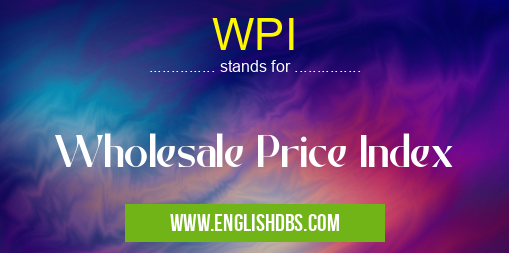What does WPI mean in GENERAL
Wholesale Price Index (WPI) is an economic indicator of the average price of a basket of selected goods at the wholesale level in a given region. It is used to measure the rate of inflation in an economy or the change in prices over time. WPI is also used to calculate changes in wage rates and consumer spending. The index serves as an important economic tool for governments, central banks, and investors to analyze trends and make economic decisions.

WPI meaning in General in Business
WPI mostly used in an acronym General in Category Business that means Wholesale Price Index
Shorthand: WPI,
Full Form: Wholesale Price Index
For more information of "Wholesale Price Index", see the section below.
WPI Full Form
The full form of WPI stands for Wholesale Price Index – it is an economic indicator used to measure average prices paid by buyers for goods purchased from manufacturers or wholesalers at the wholesale level over a specified period of time. This index helps governments, central banks and investors analyze consumer behavior patterns and make economic decisions based on current market conditions.
Essential Questions and Answers on Wholesale Price Index in "BUSINESS»GENERALBUS"
Why is the WPI important?
The Wholesale Price Index (WPI) is an important measure of inflation. It provides a clear picture of changes in industry prices, which serves as a barometer of economic health and helps to predict longer-term trends. By understanding WPI, investors can make informed decisions that will benefit their portfolios.
How often is the WPI updated?
The WPI is updated once a month by the Ministry of Commerce & Industry in India. This index seeks to capture changes in price levels every month for more than 400 commodities at various stages of production and distribution.
What factors influence the WPI?
The most influential factors that affect the WPI are fluctuations in raw materials costs, government policies such as tariffs or subsidies, demand and supply conditions, global economic conditions, exchange rates and seasonality. Any significant change to any one of these variables will have an impact on the overall level of price movement captured by the index.
How is inflation measured using the WPI?
Inflation is measured by comparing current prices to previous prices over time – also known as inflation rate - using data collected from multiple sources including wholesale markets all over India. This rate, called annual percentage change, shows how much wholesale prices have risen or declined across commodities since the previous year’s observation period.
Can you provide examples of items tracked by the WPI?
Yes, some examples include food grains such as rice and wheat; fuel products like petrol and diesel; manufactured goods like textiles and steel; metals such as aluminum and zinc; chemicals like pesticides and fertilizers; finished products like towels, blankets and furniture; vegetables such as onion and potato; fruits like apple and mango; semi-processed items like tea dusts etc.
Who uses data from the Wholesale Price Index?
Data from the Wholesale Price Index may be used by governments to decide on fiscal or monetary policy relating to pricing, businesses who use it for annual planning related to expenses during budgeting operations or liquidity management strategies as well as investors who leverage it for making investments decisions based on economic trends.
Is there a difference between CPI (Consumer Price Index) & WPI (Wholesale Price Index)?
Yes. The Consumer Price Index measures movements in retail prices experienced by consumers while Wholesale Price Index measures general movements in whole sale prices experienced by wholesalers or producers before reaching consumers. Thus while CPI tracks a basket of goods & services bought by households for direct consumption with fixed weight assigned to each item in its basket of goods & services ; wpi only includes products that are sold first in bulk quantities with changing weight assigned.
What does 'base year' mean when talking about the Wholesale Price Index (WPI)?
Every index must have a reference base year against which we compare our calculations - this year called ‘base year’ with 100 units being our index number value representing average price level at given time period. For example if we take base year 2018 then,all other future years taxa would be compared against it. So if today’s value was 110units then it would imply 10 % increase compared to base year 2018 which was 100units.
Final Words:
The Wholesale Price Index (WPI) is one of many economic indicators used by businesses to measure pricing fluctuations across industries from production to retail consumption levels over a given period of time. By monitoring this data, businesses are able to more accurately anticipate changes in pricing structures and analyze broader economic trends such as inflation or recessionary forces throughout different regions.
WPI also stands for: |
|
| All stands for WPI |
